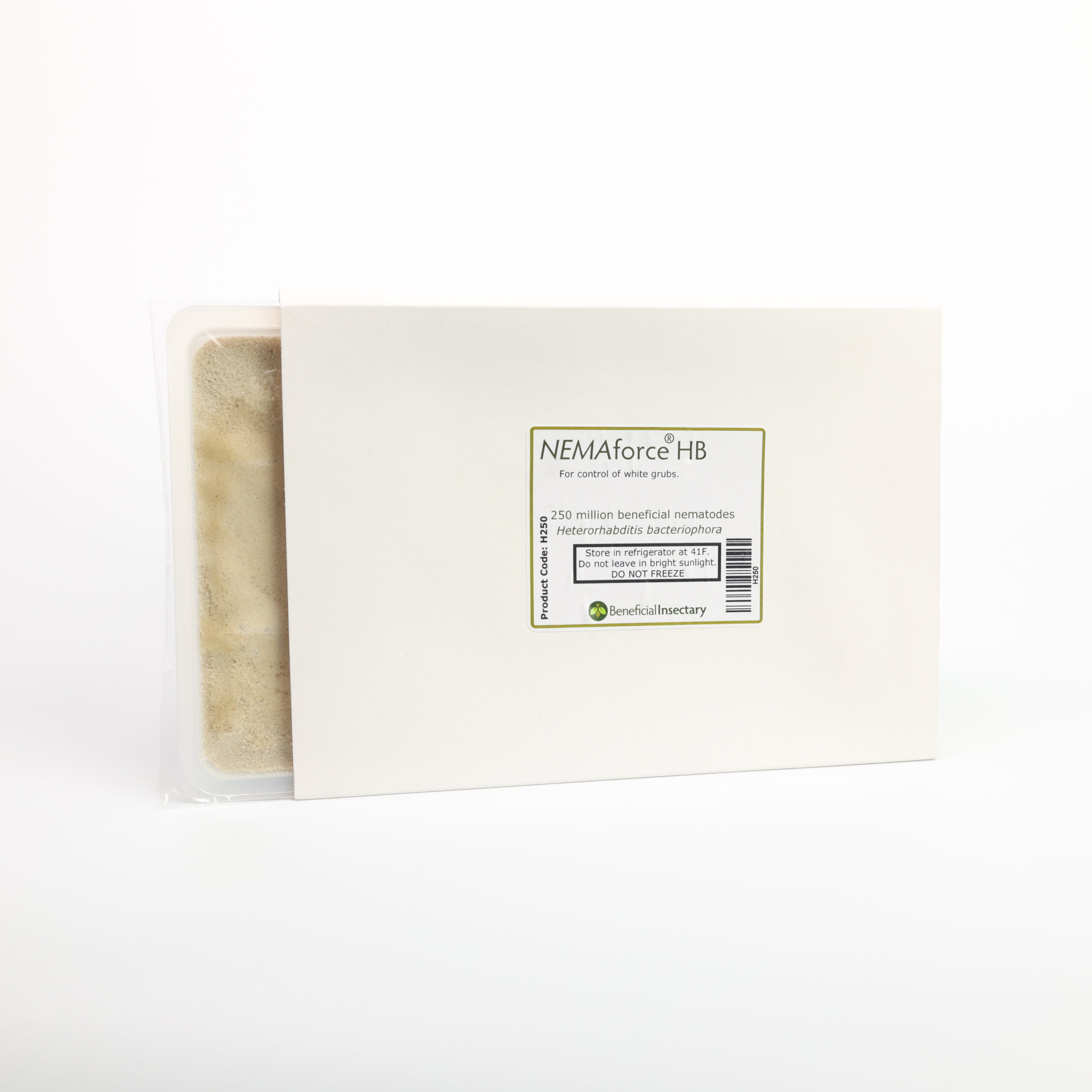NEMAforce™ HB
NEMAforce™ HB
Entomopathogenic nematode (EPN) Heterorhabditis bacteriophora
Contains an insect-killing symbiotic bacteria, Photorhabdus sp.
The optimal soil temperature range is 59-86°F.
Deep foragers preferring to live well below the soil/media surface.
‘Cruiser’ hunting style, they actively seek out their hosts.
Japanese Beetle Larvae
Apple Maggot Pupae
Cabbage Root Maggots
Carrot Rust Flies
Carrot Weevils
Spotted and Striped Cucumber Beetle Larvae
Leafminer spp. Pupae
Flea Beetle Larvae
June/May Beetle Larvae
Wireworms
Onion Maggots
Northern Corn Rootworms
And many other pests.
Soft Fruits
Turf and Lawn
Tree & Shrub Nurseries
Ornamentals
Greenhouses
Indoor Facilities
Medicinal Cannabis
Fields
Gardens


Infectious juvenile nematodes penetrate the host through natural orifices. Once in the body cavity, the symbiotic bacteria are released, killing the host insect within 24-48 hours. The nematodes will grow and multiply in the dead host. New infectious juvenile nematodes leave the dead host in search of other pests.
Storage
Upon receiving the product, please remove it from the shipping packaging and use it immediately or store it in a refrigerator at 40ºF (5ºC). DO NOT FREEZE. Ensure good air circulation around each tray. Do not use it if you are past the expiration date or incorrectly stored.
Disposal
Product and packaging waste resulting from this product, or unused, outdated product, may be disposed of on-site or at any approved waste disposal facility under federal and local regulations.
Soil should be 59-86 ºF at application and at least two weeks after
application. Agitate nematodes constantly during application. Avoid direct sunlight. Apply in the early morning or late afternoon/evening. Application before/during/after rain is highly desirable. Ensure soil is moist before application and for at least two weeks after.
Irrigate/rinse the treated area immediately after application with 0.30 cm (1/8 in) of water to move the nematodes into the soil profile. Time the irrigation to within 30 minutes under hot, dry conditions and within 2 hours under cool, wet conditions. NEMAforceTM HB can be applied using standard spray application equipment, including tank sprayers, backpack sprayers, and irrigation injection systems. Remove any filters on spray equipment, if applicable. Rinse bucket contents into the spray tank.
Continue agitation while mixing and filling the spray tank to the required volume.
Maintain sufficient agitation during application to ensure uniform dispersion of nematodes in the spray mix. Fill spray vessel or stock tank with half of the required cool, clean water. Start agitation. In a bucket, premix the required number of trays in water. Use a minimum water volume of 1 liter (1 quart) per tray. Mix thoroughly.
Although unlikely to be found in the soil, parasitized insects will be 1) dead, 2) partially deteriorated — depending on how long after initial host entry they were discovered — and 3) discolored.
This product contains living organisms that require special handling and application procedures.
DO NOT SUBDIVIDE. Once opened, use the entire tray immediately.
Use cool water for mixing and keep the tank out of direct sunlight. Remove filters that are 50 mesh or finer from application equipment and nozzles. Do not exceed 300 psi pump pressure. Do not use in application systems where nozzle aperture is smaller than 0.5mm.
Agitate nematodes constantly during application. DO NOT SPOT TREAT. Treat the entire crop at the appropriate rate.
Live-Product: Beneficial Insectary strives to guarantee the live delivery of the freshest organisms to our customers. We offer replacements or credits for any compromised shipments to our customers that report any issues or concerns within 24 hours. These issues or concerns must be relayed before releasing any organisms that are suspected of having viability issues. Please do not discard the product. You may be requested to return the shipment for further analysis.
Establishment of BCAs in Crop Settings: Many variables can negatively or positively impact BCA and pest populations in various crops we work with (pesticide applications, watering practices, improper storage methods, cultural/physical/mechanical controls, etc.). Some beneficial organisms require a steady pest presence as a food source to build their population. Others may require alternate food sources, such as pollen or nectar as an example. While other BCAs have specific photoperiod requirements for success. Due to these variables, we cannot guarantee the long- or short-term establishment of the BCAs we sell after the release of the organism(s). We will not offer refunds, discounts, or other credits on products that have already been released. Please adhere to our “Live-Product” disclosure.
Product RELEASE METHOD
PRODUCT SPECIFICATIONS
PRODUCT | PACKAGE SIZE Filler/Carrier | LIFE STAGES | PRODUCT CODE |
|---|---|---|---|
NEMAforce™ HB – 50 Million | Tray with Gel Filler | Juvenile | H50 |
NEMAforce™ HB – 250 Million | Tray with Gel Filler | Juevnile | H250 |
RELEASE RATES
TARGET | RATE | VOLUME |
|---|---|---|
European Chafer Grub | 50-100 mil./1000 ft²
2-3 bil./acre
| 65-130 gal./acre (1.5-3 gal. of water/1000 ft² |
Oriental & Japanese Beetle Grubs | 25-50 mil./1000 ft² 1-2 bil./acre | 65-130 gal./acre (1.5-3 gal. of water/1000 ft² |
Life Cycle
Stages 1-3
- For the first three live in-vivo (inside their host)
Stage 4
- For the fourth stage they're exiting that host - searching for a new host
ADULT
- Adulthood is spent in-vivo in their new host
